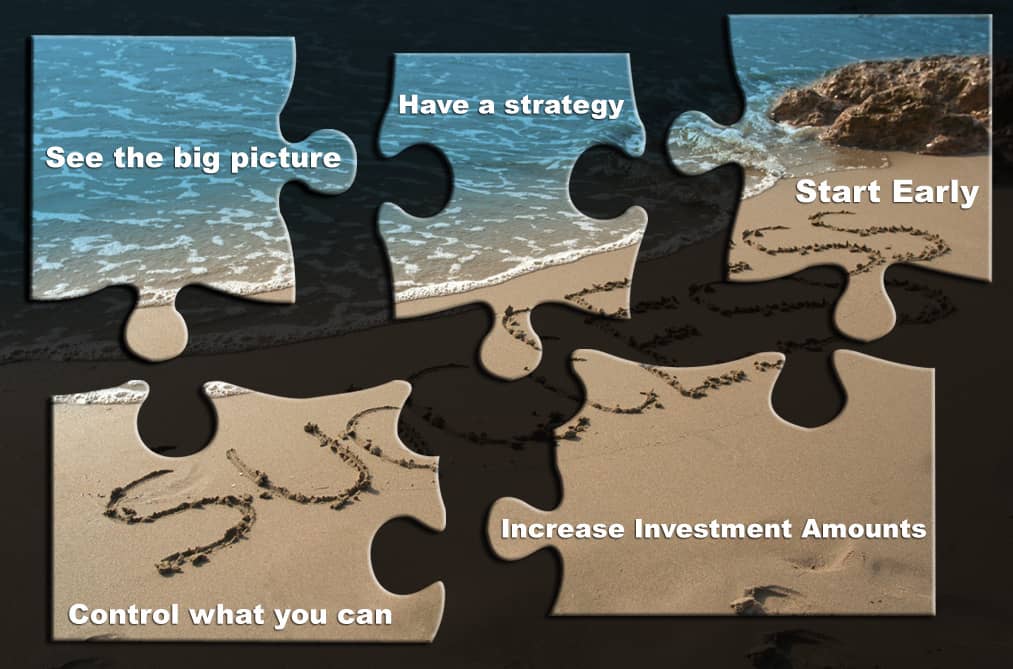5 Big Picture Things Many Investors Don’t Do

These simple strategies can make a big impact on your long term portfolio.
Investing and finances can be overwhelming and confusing. Having so many options available, how is an investor to choose which direction to go. For those who seek to understand, it can become paralysis by analysis, where the more you study, the more you realize you need to know. With all of its complexity, simple investment strategies can be very effective, if the right choices are made.
Here are 5 Strategies most average investors don’t focus on, but should.
- Have a thought out strategy with a purpose. A common mistake of investors is to put money in an account without a lot of thought as to the goals you want to achieve. Starting an investment fund without goals is like driving in a car with no destination in mind. Without a purpose for the money, it is impossible to measure the success or failure of the investment.
- Start Early with a Time Horizon. Starting early gives your money more time to grow. The longer the money is invested, the better it can weather market fluctuations and the more likely you are to successfully reach your goals. Along these same lines, set specific goals around a time horizon. How long will each bucket of money be invested? This is a very important piece to your overall strategy because it will help evaluate the specific investments that will be most beneficial. If you are 15 years away from your goal, investment choices will be much different than if you are 5. The closer you get to the destination, the less able you are weather market fluctuations. This should be considered in your overall strategy.
- Increase The Amount Invested Each Year. When looking over your investment strategy, separate the performance and the contributions. The performance is how much your money has grown through your investment strategies. Contributions are the dollar amount that you have added to your investment accounts. These two factors make up the total growth of your portfolio. Both of these numbers are important to your overall strategy. The account performance should be reviewed independent of contributions to help you stay on track with the right investment choices for your risk tolerance and time horizon. The amount you have added in contributions is what you have built into your budget for long term financial goals. When you increase those contributions each year, your account should grow significantly faster. Small increases are often not felt in the monthly budget.Let’s say you currently contribute 6% from your paycheck into your 401k. In addition to that you are putting $50 a month into your IRA and $50 a month into a college fund. At the beginning of the year, increase your 401k contribution by 1%. Now you are putting away 7% in pretax dollars for retirement. Then the next quarter increase your IRA contribution to $75 a month and the quarter after that, increase your college fund contributions by $25 a month. These small increments will barely be noticed in your monthly budget. The $25 a month increase is less than $1 a day. If you are earning $50,000 a year, the 1% increase with your 401k is only around $21 a paycheck if you get paid bi-monthly, in pretax dollars. Meaning your paycheck will be reduced by less than $20 a paycheck due to the pretax allocation. If you increase the contribution at the time of your annual raise, it will only be noticed in the form of larger investment accounts.
- Review your asset allocation as a whole picture. When you have separate investments for different financial goals, it is more of a challenge to see your portfolio in a complete picture. Having investments with different companies can increase these challenges. When you have a 401k at a current job, and maybe one or two from previous jobs, they are more difficult to keep up with. Then you might have current investments for retirement, college and savings for your first home. Taking a holistic view of all your investments will help to ensure you have the best asset allocation possible. When your allocation gets out of whack, you might end up taking on more risk than you are comfortable with, without realizing it. It is not always possible to have all your investments under one roof, especially with a current 401k. However, including these investments in all financial reviews will help you stay on track for your overall investment goals as well as ensuring your asset allocation and risk profile are appropriate.
- Understanding what you can control. In life we like to have control over our current and future destinations. Happiness and success often come from recognizing what we can control and focusing on that. Investing is no different. We cannot control the markets and we cannot control the economy. There is a host of circumstances and events that are outside of our control. Stressing and worrying about those things is not beneficial. You can control spending and investment rate. You can control which investments you choose and the amount of risk in your portfolio. Staying focused on these elements will lead to higher comfort levels which will encourage staying the course.
Financial investing success has more to do with implementing sound strategies, rather than luck or great market timing. It is more about staying the course, than picking the “hot” stock that will make you a millionaire.
Learn more about our Investment Management services.
Related Reading:
Tips for Millennials to Understanding the Stock Market
What is Dollar Cost Averaging?
Why and How to Get Started Investing Today
Mitigating Your Investment Volatility
The Psychology of Investing
Rebalance Your Portfolio to Stay on Track With Investments
Behavioral Investing: Men are from Mars and Women are from Venus!
LFS-1082064-121814
